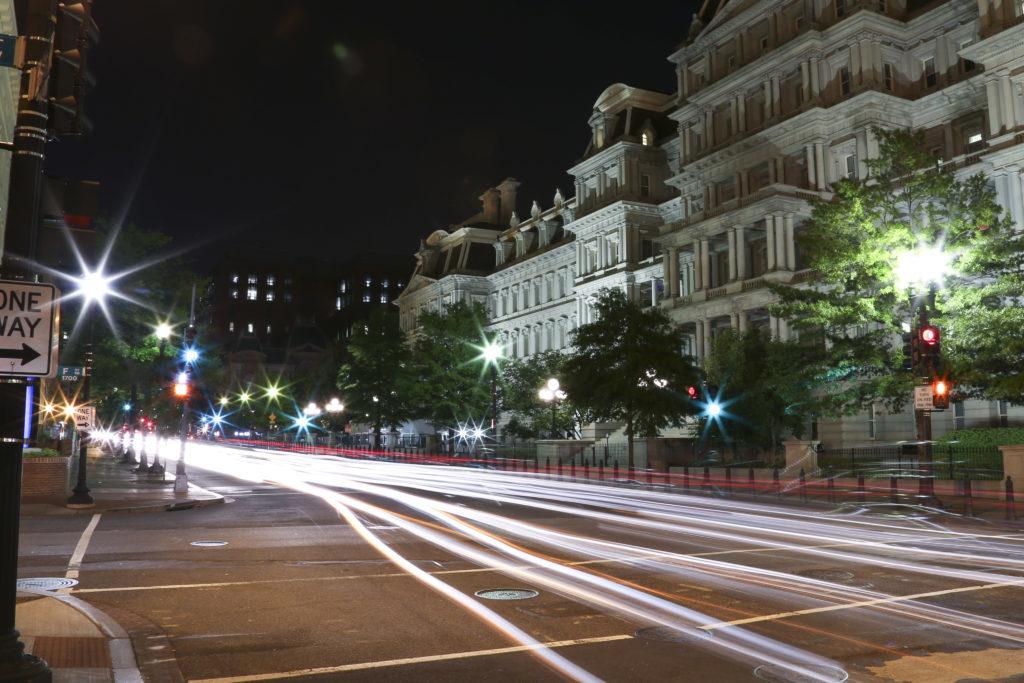Area residents are losing sleep over new energy-efficient streetlights installed in some parts of the neighborhood.
Since 2012, the D.C. Department of Transportation has been gradually installing new LED lightbulbs in streetlights. But neighbors said the new streetlights have a harsh glow that is disrupting their sleep and the Foggy Bottom and West End Advisory Neighborhood Commission is advocating for the city to install less harsh energy efficient lights.
The ANC voted unanimously April 19 to support the Street Light Task Force, an advocacy organization lobbying against the bright lights, in their efforts to replace all the new lights with other less bright alternatives and allow any commissioner to testify at a D.C. Council oversight hearing May 3.
Seventy-five lights have already been installed in Foggy Bottom along Pennsylvania Avenue and 14th and G streets.
Some neighbors said the city installed harsh LED lights – designed to save energy and decrease maintenance issues – without fully considering the impact on quality of life in residential areas.
ANC Chairman Patrick Kennedy said some Foggy Bottom residents are upset with the intensity and luminosity of the lights affecting their sleep.
“Certainly the warmer glow is much more appealing to residents than an institutional, harsh, bright light that you most commonly associate with fluorescent environments,” he said.
Kennedy said the ANC wanted to make sure DDOT was aware of scientific research on the intensity of the lights and hopes the commission’s conversation will change the policy in other parts of the city.
LEDs are bulbs that use less energy and last longer than regular lights, according to the D.C. Streetlight Policy. LEDs give off a white-colored light that is more intense than the yellow glow from previous streetlights.
Eve Zhurbinskiy, a junior and ANC commissioner, said residents are concerned about light pollution from the LED streetlights and that certain areas don’t need bright streetlights.
“I think next month ANC will probably be revisiting the issue because I think a lot of people don’t really see a point of installing really bright lights over Rock Creek Park where nobody goes at night,” she said.
Christina Farnsworth, a neighborhood resident and former real estate journalist, said she wants the city to re-evaluate the temperature of the LED streetlights to mitigate the residents’ health concerns and learn from the issues that other cities have faced when making a similar transition.
Davis, Calif. was forced to replace 650 of their newly installed LED streetlight bulbs with warmer colored bulbs after pushback from residents in 2014. Last year, the American Medical Association also warned about the possible negative health effects of LED street lighting, like messing with sleep rhythms that potentially cause insomnia and decreased appetite.
“I’m surprised that city officials in charge of this project don’t seem to be aware of the important science,” Farnsworth said in an email.
Delores Bushong, a founder of the DC Street Light Task Force, said the city should choose lower-temperature and less harsh lights instead.
Bushong said she started the group last June after the new LED streetlights were installed on her street in the Woodridge area of Northeast D.C.
“The Street Light Task Force supports the use of LED street lights,” she said. “They will save money for the city and lessen our carbon footprint. However, the public’s health must always come first.”
Bushong pointed to studies by U.S. National Library of Medicine National Institutes of Health and Harvard Health, which found the LED lights impact sleeping patterns because their blue hue suppresses a hormone that induces sleep.
Maura Danehey, a DDOT spokeswoman, said replacing all of D.C.’s traditional streetlights with LED streetlights improves safety and lessens the amount of repairs needed.
Danehey said in an email that DDOT is aware of concerns from residents and is working with the D.C. Department of Health and the Department of Energy and Environment to analyze potential health implications and test lower temperature lights. She said the LED lights are considered a neutral color and are no more harmful than the blue LED light emitted from cell phones.
“The District will choose the right standards for our city, which will direct light only to those places that need it and provide shielding to reduce light pollution,” she said.
Justine Coleman contributed reporting.




